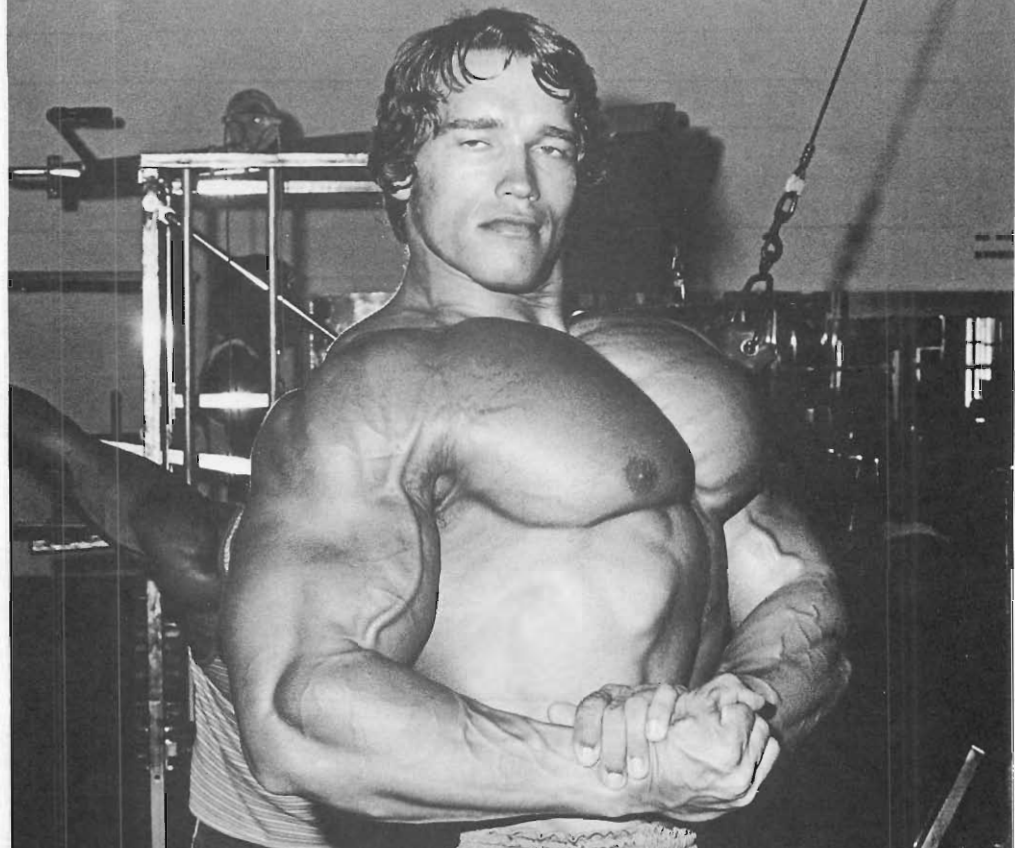Arnold Schwarzenegger’s stature in the world of bodybuilding remains unparalleled, his methods forming the cornerstone of modern bodybuilding techniques. Known for his charismatic influence, Arnold’s training routines extend far beyond his fame in cinema and politics.
His mastery in crafting a champion’s physique is particularly evident in his chest workout routines—intense sessions that contributed significantly to his seven Mr. Olympia titles. Arnold’s chest wasn’t just strong; it was meticulously chiseled, showcasing a blend of raw power and aesthetic detail.
The Chest Muscles Explained
Understanding the chest muscles is crucial for effectively targeting them during workouts. Here’s a brief overview of the key muscle groups to understand:
- Pectoralis Major: This is the largest chest muscle, covering the upper front of the chest and responsible for movements such as arm flexion, rotation, and bringing the arm back towards the body.
- Pectoralis Minor: Located underneath the pectoralis major, this smaller muscle helps in scapular movement which includes downward and forward movements.
The Importance of Overall Chest Development, According to Arnold

Arnold emphasizes that achieving a fully developed, aesthetically pleasing chest requires more than just basic exercises. It involves a comprehensive approach to target every aspect of the chest muscles—including the upper, lower, inner, and outer pectorals—as well as enhancing the rib cage to frame the muscles effectively.
Arnold highlights the complexity of perfecting the chest, noting that even significant muscle mass and rib cage size don’t guarantee an ideal chest appearance.
Key elements of a perfect chest include pronounced rib cage development, thick and detailed pectoral muscles with visible striations, and clear separation between the upper and lower sections, contributing to a square and aesthetically balanced shape.
How To Train the Chest Properly
Arnold describes two primary types of chest exercises: Flys and Presses. Flys involve drawing the arms together in a hugging motion, mainly targeting the pectoral muscles, while presses, such as the Bench Press, involve lifting weights upward off the chest, engaging the pectorals along with the front deltoids and triceps.
He stresses the importance of varying the bench angle, like incorporating Incline Presses from the start, to better develop the upper chest and avoid imbalances with the middle and lower chest regions.
He also talks about maximizing the range of motion in these exercises to intensify muscle contraction and growth. For instance, deep stretching during Flys enhances pectoral flexibility and development.
Also, Arnold believed in the importance of expanding the rib cage to improve the chest’s appearance, recommending Dumbbell Pullovers performed strictly to achieve this, but cautioning against using machines for this purpose as they might not target the intended muscles correctly.
As one advances in training, Arnold advises incorporating more detailed and varied exercises to ensure comprehensive development of all pectoral areas. He also suggests supersets combining chest and back exercises, like pairing Bench Presses with Chin-ups, to optimize training efficiency and muscle stretching. In more advanced stages, focusing on the serratus muscles becomes crucial as their development contributes significantly to demonstrating both muscle mass and quality.
Detailed Breakdown of Arnold’s Chest Workout
Barbell Flat Bench Presses

The Bench Press is a staple in chest development routines, known for building mass and strength across the entire chest as well as the front deltoids and triceps, making it a crucial compound movement for upper body strength.
How to Do the Bench Press:
-
- Lie on a flat bench with your feet firmly on the ground for stability.
- Grip the bar slightly wider than shoulder-width to ensure that when lowered, your forearms are perpendicular to the floor.
- Unrack the bar and hold it straight above your chest with arms locked.
- Slowly lower the bar to your chest, ensuring it lightly touches below the pectorals.
- Press the bar back up to the starting position, fully extending your arms .
Sets/Reps: Perform 5 sets of 6-10 reps.
Arnold’s hand position was key, so that the pecs do the work, and the front delts and triceps don’t get placed under too much stress. He also emphasized that the forearms being perpendicular to the floor because that helps make sure that the entire pectoral muscle (inner, outer, and through the middle) gets worked properly.
Remember to always go through a full range of motion during the bench press, and be under control.
Incline Bench Press

Targeting the upper pectoral muscles and the front deltoids, the Incline Bench Press shifts the focus from the mid to the upper chest, crucial for achieving a well-rounded and sculpted chest appearance.
Note that with the incline press, you won’t be able to press as much as you can with the flat bench press, which is normal.
How to Do the Incline Bench Press:
-
- Set an incline bench at about 45 degrees.
- Lie back and grip the bar with a medium-wide grip.
- Unrack the bar and hold it above your chest with arms extended.
- Lower the bar to the upper chest, pause briefly.
- Push the bar back to the starting position, locking out your arms.
Sets/Reps: 4 sets of 8-12 reps.
With the incline bench, it’s very important to optimize the bar path, or else you might be drifting the bar too far forward.
Dumbbell Flyes

Arnold used Dumbbell Flyes to enhance the mass of the pectorals, focusing on the movement across the body to stretch and contract the chest muscles maximally.
How to Do Dumbbell Flyes:
-
- Lie on a flat bench with a dumbbell in each hand, arms extended above the chest.
- With a slight bend in the elbows, lower the weights in a wide arc until your chest feels fully stretched.
- Bring the dumbbells to a complete stop at the lowest point, and really feel the stretch.
- Bring the dumbbells back up along the same path, focusing on hugging motion without pressing the weights.
Sets/Reps: 3 sets of 10-12 reps.
Make sure to keep those elbows bent slightly so that you do not injure your elbows.
Dips
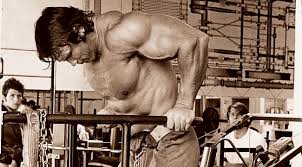
Dips are effective for developing lower chest density and overall thickness. Arnold often added weight to intensify this exercise, enhancing the load on the chest and triceps.
How to:
- Secure a weight around your waist and approach the parallel bars.
- Grip the bars and push yourself up to a starting position with your arms locked.
- Lean forward slightly and lower your body until there is a significant stretch in the chest.
- Push back up to the starting position, focusing on using the chest muscles to lift your body.
The further forward you lean, the more chest you involve. So if you shift your center of gravity forward, you will hit the pec muscles harder!
Cable Crossovers
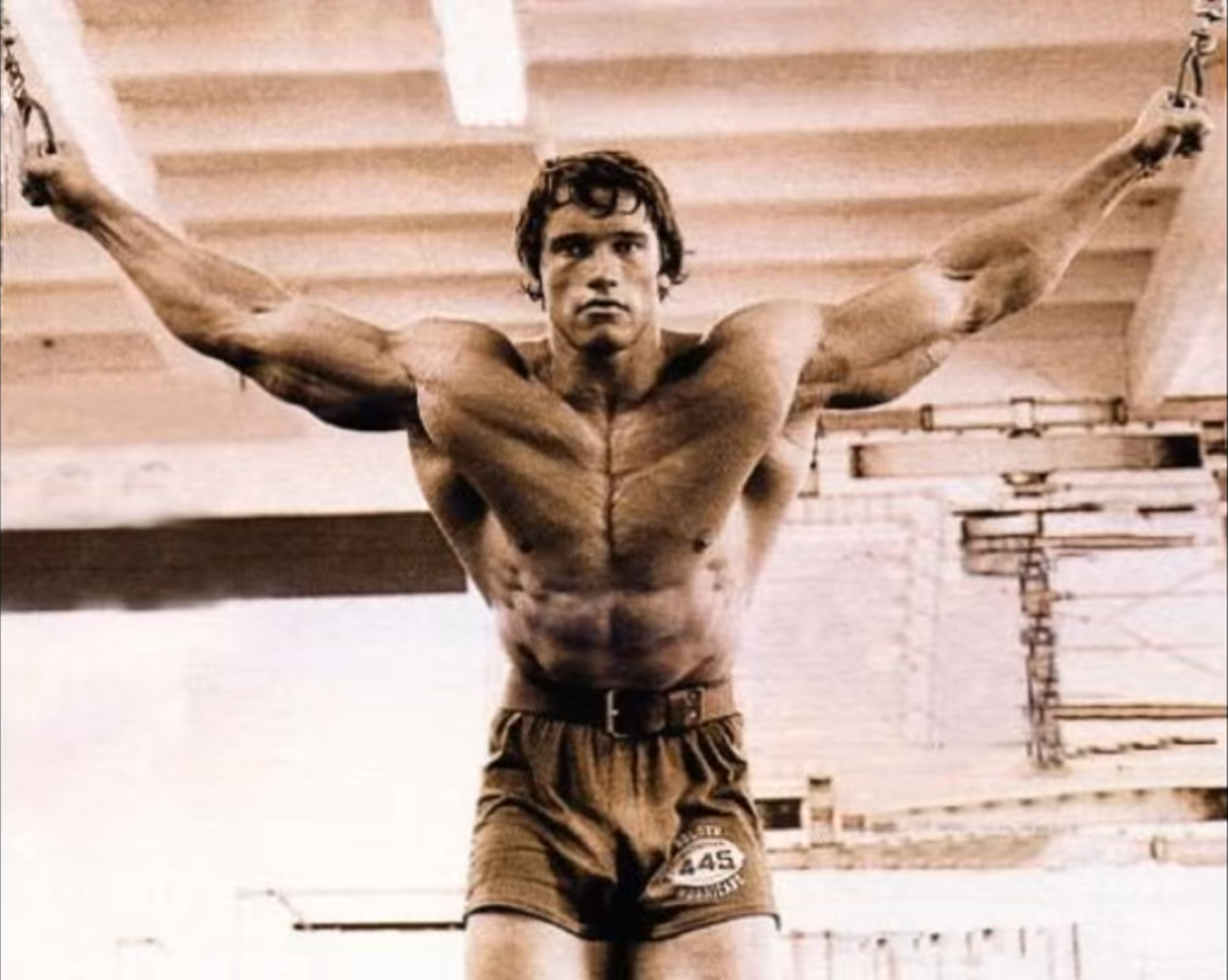
Ideal for defining the inner (and lower) chest muscles, Cable Crossovers were used by Arnold to bring out the striations and separation in the pectorals, essential for competition aesthetics.
How to Do Cable Crossovers:
-
- Stand between two pulleys set at about shoulder height.
- Takea slight step forward
- Grab the handles with your palms facing down, extending your arms almost completely outwards.
- With a slight forward lean and elbows slightly bent, bring your hands together in a sweeping arc.
- Cross one hand over the other at the center, squeezing the chest muscles tightly.
- Alternate the crossover of hands with each rep to maximize contraction.
Sets/Reps: 3 sets of 12-15 reps.
Dumbbell Pullovers

Dumbbell Pullovers are a unique exercise that Arnold Schwarzenegger frequently used not only to target the chest and lats but also to expand the rib cage. This expansion is critical for achieving a more dramatic V-taper appearance, which enhances the aesthetic appeal of the upper body.
Arnold believed that this exercise was instrumental in developing an impressive chest silhouette and improving the overall structure of the upper body by also engaging the serratus anterior and intercostals.
How to:
- Choose a moderate weight dumbbell and lie perpendicular on a flat bench so that only your upper back rests on the bench. Your hips should be lower than your body, and your legs bent at the knees with feet firmly planted on the floor for stability.
- Hold the dumbbell with both hands directly above your chest, arms extended. Your palms should press against the underside of one of the dumbbell’s plates.
- With a slight bend in your elbows to lock them into position, slowly lower the dumbbell back over your head. Keep your hips slightly dropped to enhance the stretch across your rib cage.
- Lower the dumbbell in an arc behind your head until you feel a deep stretch in your chest and lats. The movement should be controlled and deliberate to avoid any strain on your shoulders.
- Bring the dumbbell back to the starting position using the same controlled motion, focusing on engaging the chest muscles and lats to lift the weight.
Sets/Reps: Arnold often performed 3-4 sets of this exercise for 10-12 reps within his chest or back workouts to maximize the stretch and growth of the involved muscles.
Arnold’s Tips for Maximizing Chest Development
Arnold’s approach went beyond just lifting weights; it was about understanding the muscle, its functions, and how to effectively load it.
Weak Point Training
Schwarzenegger stresses the importance of focusing on specific areas of the chest that may be lagging to achieve a balanced and fully developed physique. He emphasizes that performing a variety of exercises isn’t enough—each exercise should target distinct regions of the chest such as the inner, outer, upper, and lower pectorals.
Grip Variations
Techniques like adjusting grip width on bench presses can emphasize different parts of the chest, with narrow grips enhancing inner pectorals and wider grips focusing on the outer areas. Arnold recommends starting workouts with exercises that target weaker sections when energy levels are highest.
Technique and Full ROM
He also discusses the significance of precise technique and full range of motion to maximize muscle contraction and growth, such as altering the angle of incline presses to shift focus between the middle and upper pectorals, creating clear definition and separation that enhances competition aesthetics.
Through tailored workout plans that address specific weaknesses and emphasize detailed execution, Arnold advocates for a methodical approach to chest development.
Sculpting the Serratus: Arnold’s Approach
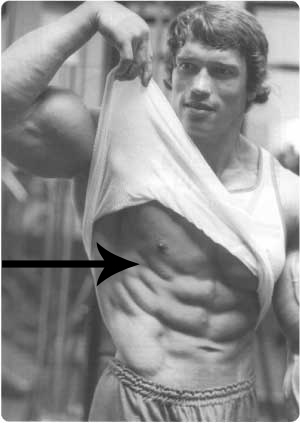
Arnold emphasized the importance of the serratus muscles in achieving a visually impactful and detailed physique of the upper body. These muscles, located along the rib cage, are crucial for defining the separation between the lats, chest, and obliques, enhancing the overall aesthetic of a bodybuilder.
Key Benefits of Serratus Development:
- Visual Impact: Well-defined serratus muscles resemble “fingers” across the ribcage, improving the body’s visual symmetry and athletic appearance.
- Functional Benefit: They aid in movements that involve raising the arms and contribute to a more effective pose on stage.
Training Tips:
- Focused Exercises: Incorporate movements like Chin-Ups, Narrow-Grip Pulldowns, and Dumbbell Pullovers, which engage and isolate the serratus.
- Intensity in Training: Arnold stressed the need for intense and targeted exercises to fully develop the serratus
Arnold’s Different Chest Programs
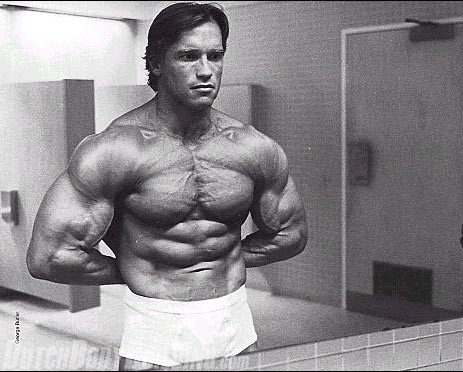
Early in his career, he focused on basic exercises like Bench Presses, Incline Presses, Dumbbell Flys, Dips, and Pullovers, which he continued for several years.
After identifying weaknesses, such as underdeveloped upper pecs, Arnold adjusted his routine to emphasize Incline Presses significantly. This change was crucial in developing his upper chest, highlighting the importance of adapting training strategies to address weak points.
Arnold’s training philosophy includes the Priority Principle, training weaker areas first when energy levels are highest, and the Shocking Principle, introducing new movements to stimulate muscle growth.
His innovative methods, like performing Incline Presses in a unique and challenging manner with Reinhard Smolana, not only increased his chest strength and size but also taught him the value of power training with heavy weights.
As Arnold progressed, he incorporated more complex isolation movements and techniques such as supersets and tri-sets, combining chest and back exercises. This approach not only enhanced the muscle pump but also made sure he had balanced development by working opposing muscle groups simultaneously.
Arnold’s competition training evolved to include meticulous attention to detail, focusing on achieving a polished, muscular, and defined chest appearance necessary for success in bodybuilding contests.
Conclusion
Arnold’s chest routine is a testament to his disciplined approach to bodybuilding. By incorporating these methods into your routine, you too can build a chest worthy of competition, underscored by strength, balance, and aesthetic appeal.
Remember, the key to success is consistency, proper nutrition, and adequate rest, combined with a relentless pursuit of improvement.
Whether you’re just starting or are an experienced lifter, integrating aspects of Arnold’s philosophy can transform your approach and results.
To learn more about how to train like Arnold, read our articles on Arnold’s back workout, arm workout, leg workout, and shoulder workout.
References
- Schwarzenegger, Arnold, and Bill Dobbins. The New Encyclopedia of Modern Bodybuilding. Simon & Schuster, 1998.
- Gaines, Charles, and George Butler, directors. Pumping Iron. White Mountain Films, 1977.

